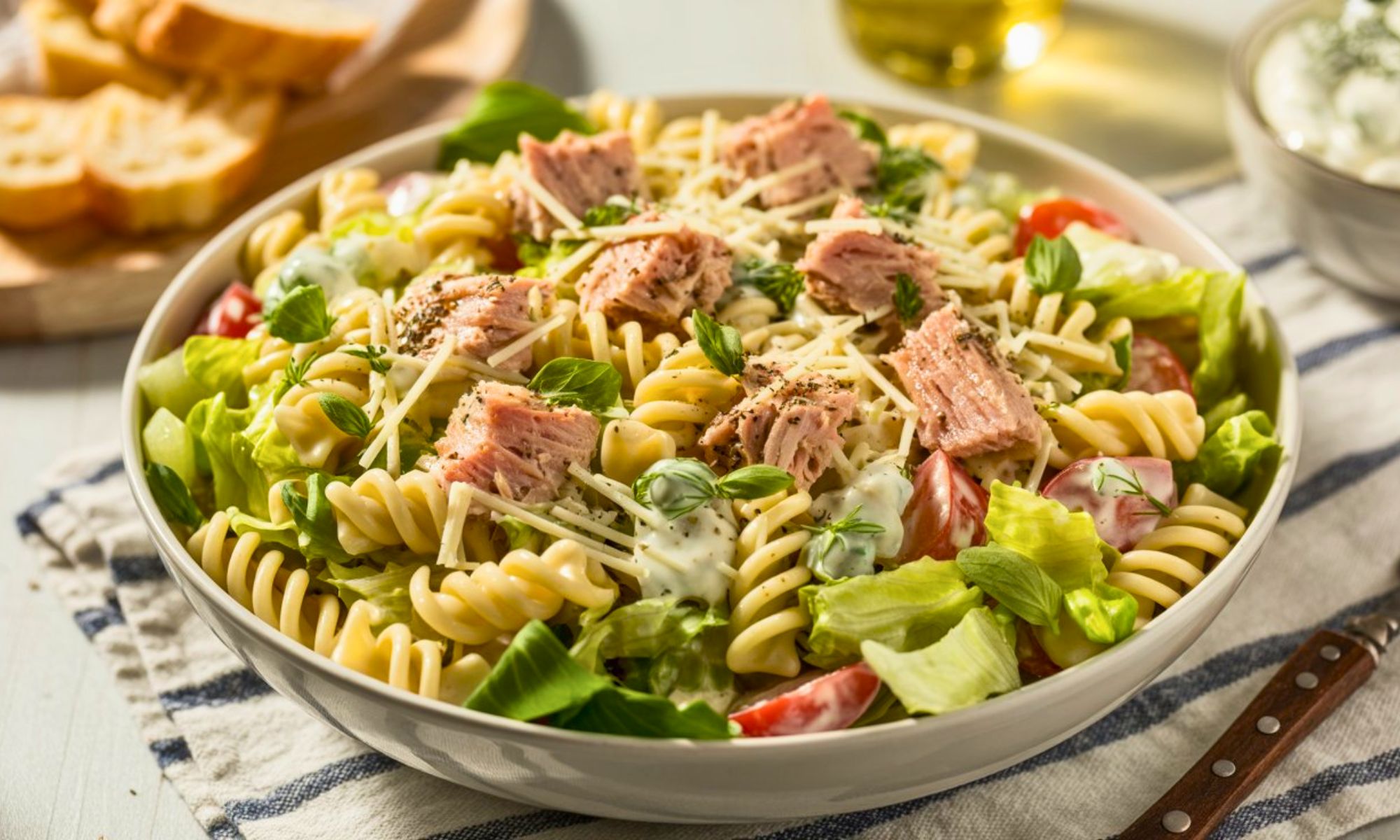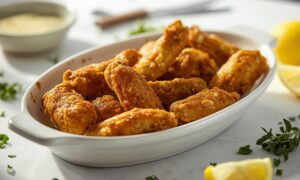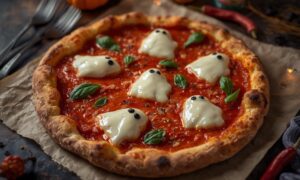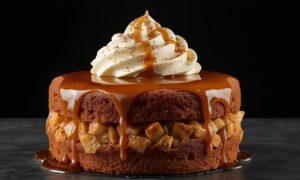Delightful Tuna Pasta Salad is the perfect blend of comfort and convenience, quick to make, refreshing to eat, and surprisingly satisfying. With tender pasta, flaky tuna, crisp veggies, and a creamy, zesty dressing, it’s ideal for warm days, busy lunches, potlucks, or laid back family dinners. It strikes that rare balance between being light yet filling, familiar yet fresh.
The first time I made this, it was a hot summer day and the fridge was nearly empty, just some leftover pasta, a can of tuna, and chopped veggies from the night before. With a quick mix of mayo, mustard, and lemon, something simple turned into something special. That last minute meal quickly became a go to dish, one I now make for all kinds of occasions.
In this post, I’ll guide you through crafting your own Delightful Tuna Pasta Salad, complete with tips to keep your pasta perfectly textured, your flavors vibrant, and your variations fun and adaptable, whether you like it bold, creamy, or Mediterranean style.
1. Ingredients & Substitutions
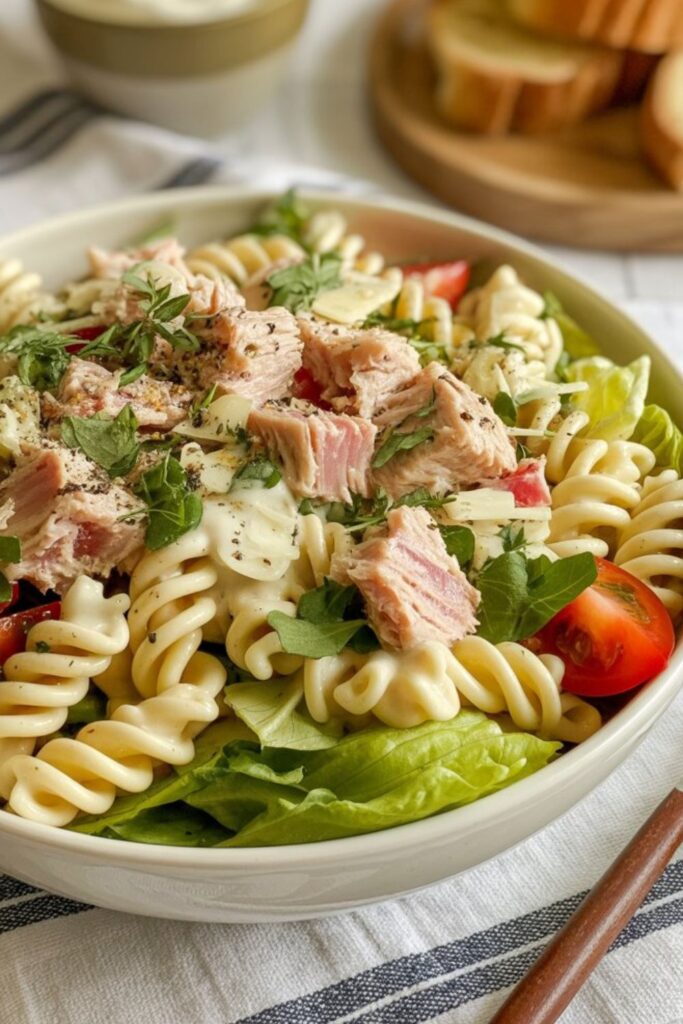
The Foundation Elements
- 12 ounces short pasta (fusilli, farfalle, or rotini)
- 2 cans (5-6 ounces each) solid albacore tuna in water, drained
- 1 cup mayonnaise (preferably Duke’s or Kewpie)
- 2 tablespoons Dijon mustard
- 3 tablespoons fresh lemon juice
- 1 cup celery, finely diced
- 1/2 cup red onion, finely diced
- 1/3 cup fresh parsley, chopped
- 1/4 cup dill pickles, minced
- 2 tablespoons capers, rinsed and chopped
- 2 hard boiled eggs, chopped (optional)
- Salt and freshly ground black pepper, to taste
The pasta you choose matters more then most cooks realize. Rotini and fusilli capture dressing in their spirals, while farfalle provides textural interest. For gluten free options, chickpea or lentil pasta not only accommodates dietary restrictions but adds protein and a nutty depth that complements tuna beautifully. Skip rice pasta, which tends to break down too quickly in cold salads.
When it comes to tuna, solid albacore packed in water delivers the cleanest flavor and firmest texture. Oil packed tuna introduces a richness that can sometimes overwhelm the other components, though Italian tonno preserved in olive oil can be divine for special occasions. For plant based alternatives, chickpeas mashed with a touch of nori provide a surprisingly convincing substitute—the oceanic notes from seaweed bridge the flavor gap.
The Dressing Components
The dressing is where your salad’s personality emerges. Mayonnaise provides creaminess, but the source matters. American Southern style Duke’s offers tangy notes without sweetness, while Japanese Kewpie introduces umami through MSG and egg yolks. Greek yogurt can replace up to half the mayo for a lighter, protein rich alternative with pleasant acidity, particularly valuable during warmer months when food safety concerns peak.
Dijon mustard acts as both emulsifier and flavor enhancer. The vinegar in Dijon brightens the entire dish while providing crucial acidity that balances the richness of mayonnaise. For those avoiding mustard, an equivalent amount of horseradish provides similar pungency and emulsification properties.
Fresh lemon juice is non negotiable bottled versions simply cannot replicate the vibrant, aromatic qualities of fresh citrus. The volatile compounds in fresh lemon zest and juice degrade rapidly after extraction, which explains why bottled versions taste flat by comparison.
The Texture and Flavor Enhancers
Celery contributes essential crunch and subtle herbaceous notes. For maximum crispness, soak diced celery in ice water for 10 minutes before draining thoroughly and incorporating. This simple technique heightens texture by reinforcing cellular structure.
Red onion delivers pungency that creates dimension, but can sometimes overwhelm. To tame its intensity, soak diced onion in cold water for 15 minutes, which leaches out sulfurous compounds while preserving crisp texture. Alternatively, pickled red onions introduce both acidity and color without the harsh bite.
Fresh herbs are transformative additions that professional chefs wouldn’t dream of omitting. Parsley offers grassy brightness, while dill introduces anise notes that complement seafood naturally. Chives provide onion flavor without harshness, making them an excellent inclusion for those sensitive to raw alliums.
Pickles and capers contribute crucial briny notes and umami. These salt preserved ingredients activate salivation and enhance perception of other flavors the reason they appear in so many classic salads. For those monitoring sodium intake, quick pickled vegetables (cucumber, radish, or celery) made with less salt can provide similar brightness.
2. Step by Step Instructions
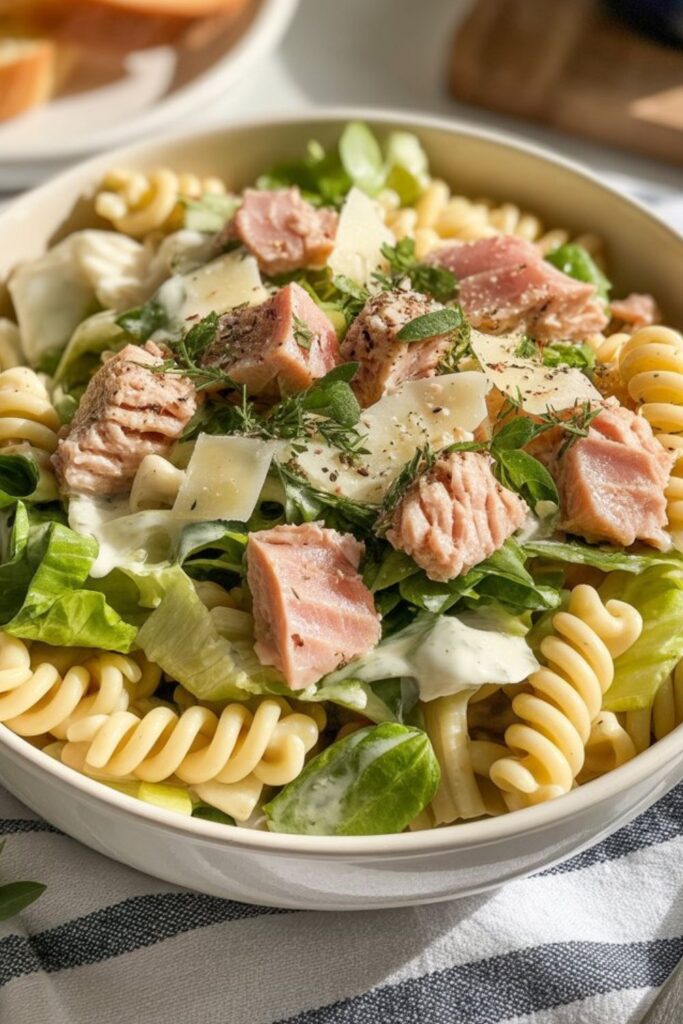
Cooking the Pasta
- Bring a large pot of water to a rolling boil, then add salt until it tastes like seawater (approximately 1 tablespoon per quart). This aggressive seasoning is your only opportunity to flavor the pasta itself.
- Cook pasta 1-2 minutes beyond al dente, as cold temperatures firm texture considerably. Test by biting through a piece the center should be tender without any chalky resistance, but not mushy.
- Drain thoroughly but don’t rinse unless you’re not dressing immediately. The surface starch helps dressing adhere, but if making ahead, a quick rinse prevents clumping during cooling.
ordinary mistake: Undercooking pasta for cold salads. While al dente is perfect for hot dishes, cold pasta salads require slightly softer texture since chilling firms the starch structure. Trust me, pasta that’s perfect when hot will be unpleasantly firm once chilled.
Preparing the Tuna
- Drain canned tuna thoroughly, pressing gently in the can to extract excess moisture without crushing the flakes. This prevents watery dressing later.
- Transfer to a bowl and flake with a fork, maintaining some texture rather than mashing completely. Varying sized chunks create interest in the final dish.
- For enhanced flavor, try briefly marinating the flaked tuna in a tablespoon of lemon juice and zest while preparing other ingredients. This quick step brightens the tuna’s flavor profile considerably.
Tuna quality varies dramatically between brands. Look for sustainably caught albacore with firm texture. Budget brands often use skipjack tuna, which has a stronger fishy flavor and mushier texture that can compromise your finished salad.
Creating the Dressing
- In a large bowl, whisk together mayonnaise, Dijon mustard, lemon juice, 1/2 teaspoon salt, and 1/4 teaspoon freshly ground black pepper until smooth and fully integrated.
- Add a teaspoon of honey if desired to round flavors, particularly when using more acidic components like capers and pickles. The hint of sweetness won’t register as such, but will balance acidity.
- Taste and adjust seasoning, remembering that flavors mute slightly when cold. The dressing should taste slightly too bright at room temperature.
Pro tip: Add a teaspoon of anchovy paste to the dressing for remarkable depth without discernible fishiness. This umami rich ingredient amplifies other flavors without announcing its presence a classic chef’s secret for elevating seafood preparations.
Assembly and Integration
- Combine cooled pasta with the dressing first, tossing thoroughly to coat each piece. This creates a flavor base that prevents bland bites.
- Fold in tuna gently to maintain texture, followed by celery, red onion, herbs, pickles, capers, and eggs if using. Each component should be distributed evenly but identifiable.
- Cover and refrigerate for at least 1 hour before serving, ideally 2-4 hours. This resting period allows flavors to harmonize and the pasta to absorb dressing components.
The most significant mistake home cooks make is under seasoning pasta salad. Cold temperatures dull our perception of flavor, requiring more assertive seasoning than hot dishes. Always taste and adjust after chilling, adding more salt, pepper, or acid as needed.
3. Cooking Techniques & Science
The Critical Role of Pasta Cooking
Pasta salad texture hinges on understanding starch behavior. When pasta cooks, starch granules absorb water and gelatinize, softening the rigid structure. Upon cooling, these starch molecules retrograde (realign), creating firmer texture through a process similar to bread staling. This scientific reality necessitates cooking pasta slightly longer for cold applications.
The pasta cooking water’s salinity affects not just flavor but texture. Properly salted water strengthens gluten structure, resulting in pasta that holds its shape better when mixed with dressing and other ingredients. Under salted pasta water produces bland, floppy noodles that can’t stand up to robust dressings.
Emulsion Stability in Dressings
The creaminess of tuna pasta salad depends on maintaining a stable emulsion in the dressing. Mayonnaise itself is an emulsion of oil suspended in water with egg as emulsifier. When we add acidic components like lemon juice, we risk breaking this emulsion unless properly balanced.
Mustard contains naturally occurring emulsifiers that help stabilize the dressing, preventing separation even after days in the refrigerator. This explains why almost all professional pasta salad recipes include mustard or another emulsifying agent like egg yolk.
Flavor Development Through Resting
The transformation that occurs while tuna pasta salad rests isn’t just psychological it’s chemical. Water soluble flavor compounds migrate throughout the dish during refrigeration, while fat soluble flavors infuse the oils in the dressing. This migration creates unified flavor that can’t be achieved through immediate serving.
The textural interplay between ingredients also evolves during resting. Pasta absorbs slight moisture from dressing, vegetables release small amounts of water, and proteins like tuna and egg slightly firm. This equilibrium creates the distinctive mouth feel that makes properly rested pasta salad superior.
4. Serving & Pairing Suggestions
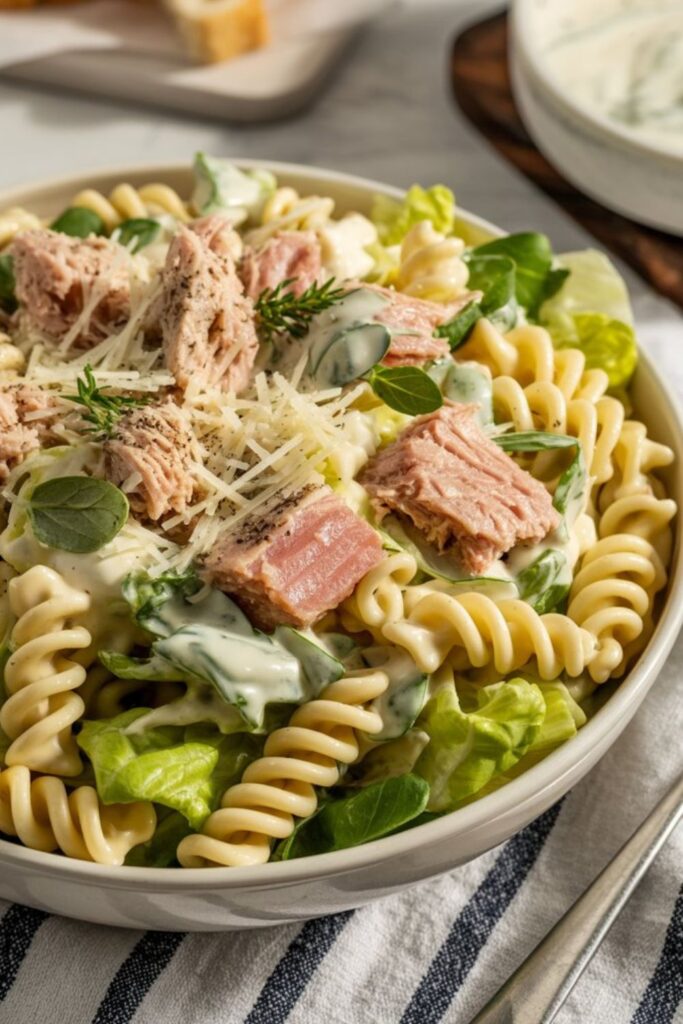
Presentation Approaches
Tuna pasta salad benefits from thoughtful presentation despite its casual reputation. For individual portions, try serving in radicchio cups or butter lettuce leaves, where the slight bitterness contrasts beautifully with the creamy dressing. A scattering of microgreens or finely sliced chives adds visual appeal and textural contrast.
For family style service, consider a shallow platter rather than deep bowl, allowing the colorful components to remain visible. A light dusting of paprika or sumac around the edges adds professional flair without pretension. Fresh lemon wedges alongside provide interactive customization for guests.
Temperature Considerations
Remove tuna pasta salad from refrigeration 15-20 minutes before serving. Temperature impacts flavor perception dramatically straight from the fridge salad will taste muted compared to the same dish at cool room temperature (around 65°F). This brief tempering period awakens flavors without compromising food safety.
Complementary Pairings
Tuna pasta salad pairs beautifully with acidic, crisp white wines like Sauvignon Blanc or dry Riesling. The wine’s brightness cuts through the creamy richness while complementing the seafood elements. For non alcoholic options, sparkling water with cucumber and lemon provides similar palate cleansing effects.
For complete meal composition, consider serving alongside grilled vegetables brushed with herb oil, which provide contrasting preparation method and temperature. Warm, crusty bread with cultured butter creates textural counterpoint to the softness of the salad.
Conclusion
The distinction between ordinary tuna pasta salad and an exceptional version lies not in exotic ingredients, but in thoughtful technique and balance. By properly cooking pasta, creating stable emulsified dressing, incorporating textural variety, and allowing proper resting time, you transform a humble dish into something worthy of culinary respect.
Remember that this salad improves over 1-2 days as flavors integrate, making it an ideal make ahead option for entertaining or meal preparation. Store no longer than three days for food safety and optimal texture. The versatility of this dish extends beyond the recipe view it as a framework for seasonal adaptation. Try adding blanched spring asparagus, summer cherry tomatoes, or autumn roasted squash to reflect the changing produce calendar.
Tuna pasta salad carries nostalgia and comfort, but executed with professional attention to detail, it also demonstrates culinary understanding that translates to all cooking endeavors. Master this seemingly simple dish, and you’ve gained insight into fundamental principles of flavor development, textural balance, and ingredient harmony applicable across your culinary repertoire.
Tuna Pasta Salad: Common Questions
How far in advance can I make tuna pasta salad?
Optimally, prepare tuna pasta salad 4-24 hours before serving. It remains food safe for up to three days refrigerated, but texture begins deteriorating after 48 hours as pasta continues absorbing moisture from the dressing.
Why does my tuna pasta salad dry out overnight?
Pasta continues absorbing liquid during storage. Reserve a few tablespoons of dressing separately and fold in just before serving to refresh texture. Alternatively, a splash of lemon juice and drizzle of olive oil restores moisture without heaviness.
Can I freeze tuna pasta salad?
I don’t recommend freezing. The emulsified dressing breaks upon thawing, while pasta and vegetables develop unpleasant textures. For meal prep, prepare components separately and assemble within 24 hours of serving.
How do I prevent my pasta salad from tasting bland?
Cold temperatures suppress flavor perception. Season more assertively than for hot dishes, ensure pasta cooking water is properly salted, incorporate acid through lemon juice or vinegar, and allow the salad to rest at room temperature 15 minutes before serving.
What’s the best pasta shape for tuna pasta salad?
Choose shapes with ridges, curves, or hollows that capture dressing. Rotini, fusilli, farfalle, and orecchiette excel. Avoid long strands like spaghetti or delicate shapes like angel hair that break easily during mixing.

Swiftly Captions by Tina Smith — Quick, flavorful food recipes made simple, bringing fresh inspiration to your kitchen every day
